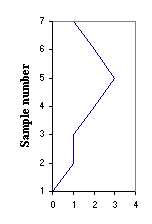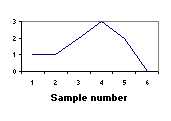![Test signal, x[t]](figure6_6.jpg)
![Reference pattern, y[t]](figure6_7.jpg)
Suppose we wish to compare and evaluate the difference between
the following two signals:
![Test signal, x[t]](figure6_6.jpg) |
![Reference pattern, y[t]](figure6_7.jpg) |
| a) (Input) test signal, x[t]: | 1 | 1 | 2 | 3 | 2 | 0 | |
| b) (Stored) reference signal, y[t ]: | 0 | 1 | 1 | 2 | 3 | 2 | 1 |
| Sample-by-sample difference x[t] - y[t]: | 1 | 0 | 1 | 1 | -1 | -2 | undefined |
Both signals are similar in that they are single-peaked. However, the stored reference signal is longer than the test signal, and the peak is later. In other words, the two signals are not synchronized in time.
To calculate the difference between them, consider a matrix of the
distance
between every sample of x[t] and each sample of y[
t]. The distance matrix D is:
|
y[t] |
 |
|
||||||||||||||||||||||||||||||||||||||||||||||||||||||||

x[t]
|
There is a sequence of low numbers, close to the diagonal, indicating which samples of x[t] are closest in value to those of y[t]. These are marked in red.
Instead of a simple subtraction, it is customary to use a symmetrical
distance measure, such as (x[t] - y[t])
2 :
| y[t] |
|
||||||||||||||||||||||||||||||||||||||||||||||||||||||||
|
x[t]
|